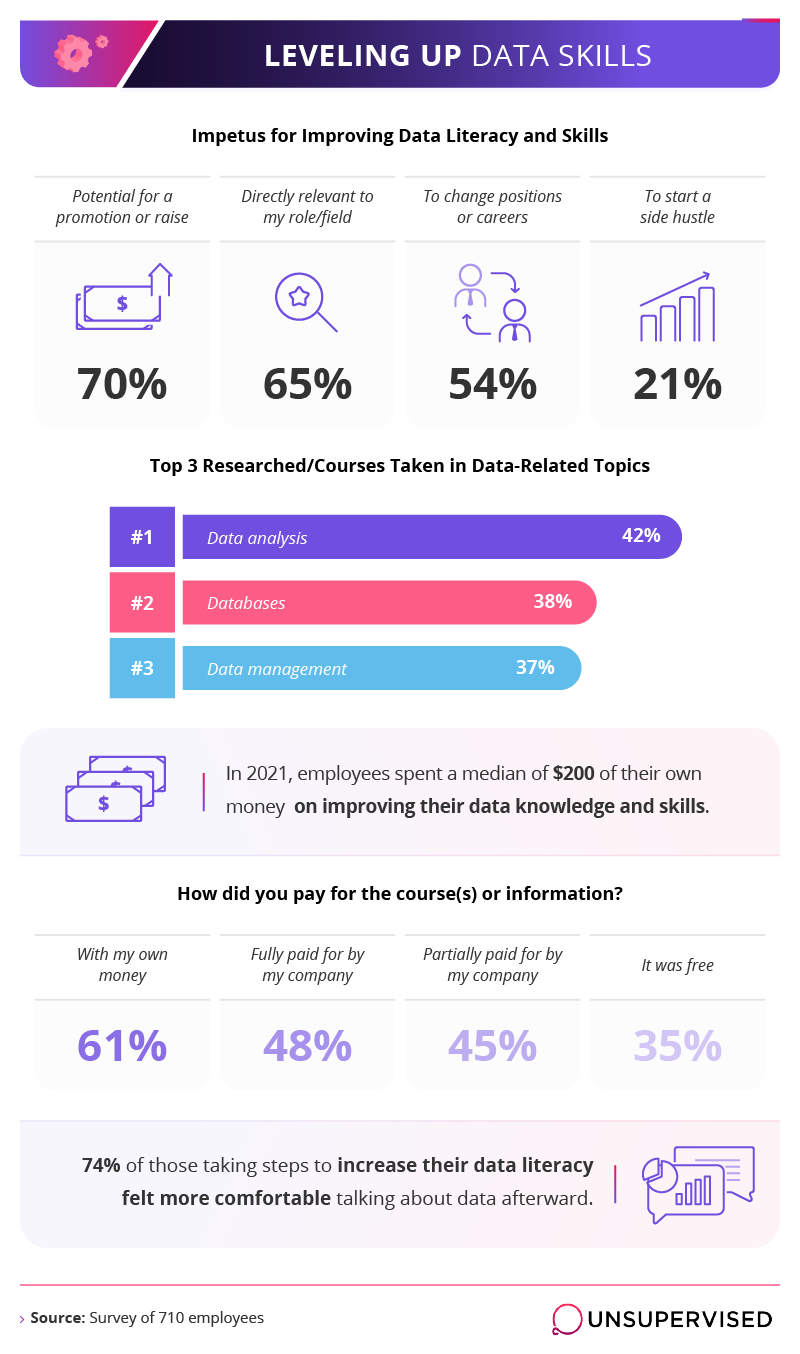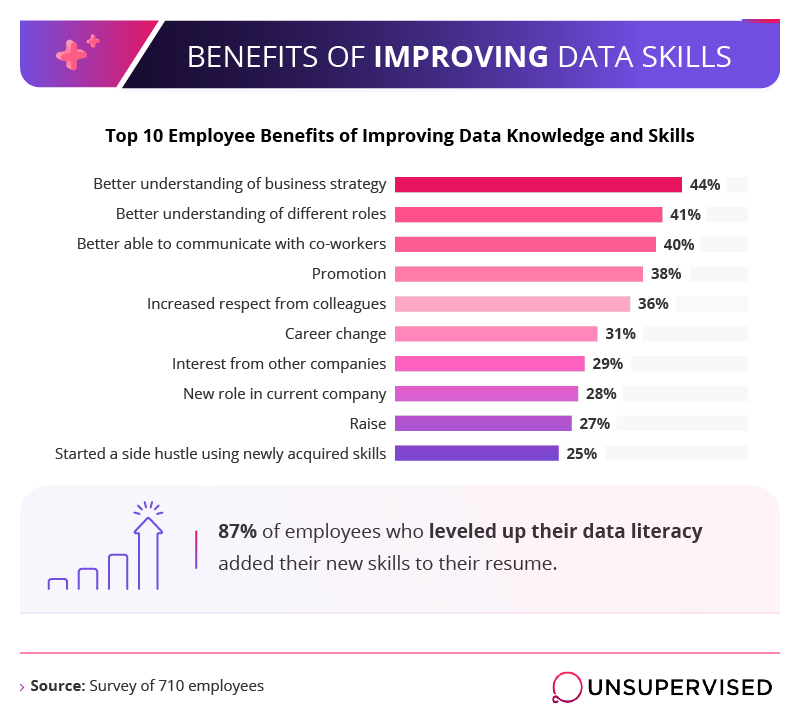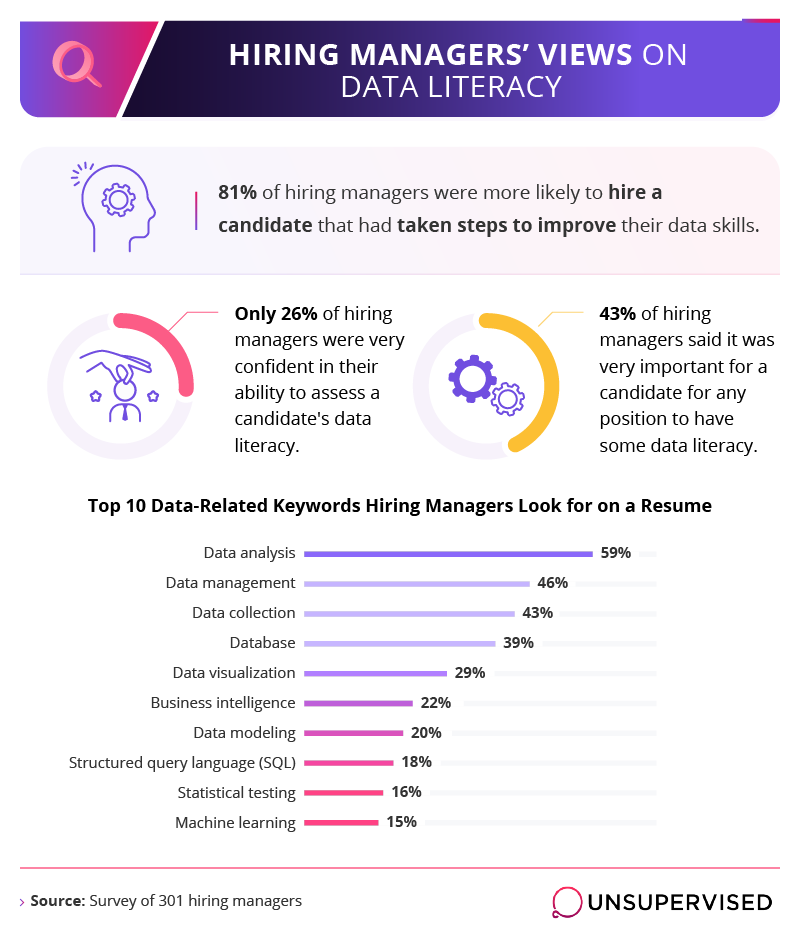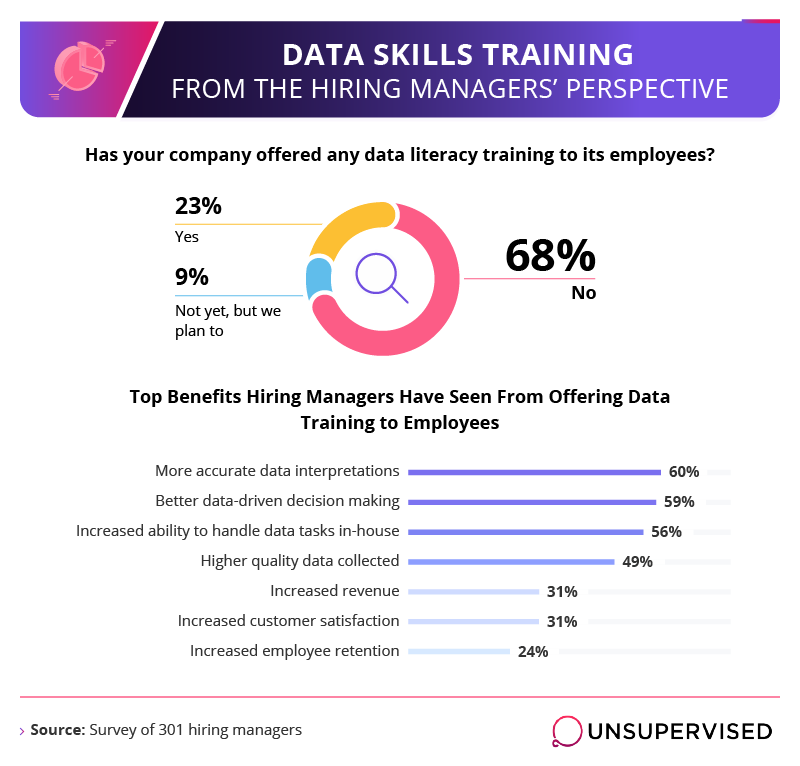Have You Increased Your Data Skills? If Not, You Might Be Getting Left Behind

Key Findings
- 54% of employees were interested in improving their data literacy and skills in order to change their position or career.
- Last year, employees spent a median of $200 of their own money to level up their data skills.
- 31% of hiring managers reported increased revenue as a result of leveling up their employees’ data skills.
- 81% of hiring managers were more likely to hire a candidate that had taken steps to improve their data skills.
Data literacy in the workplace is quickly becoming—or perhaps already is—an essential skill. Even in a role outside data science, the ability to interpret and utilize the data your team is given can catapult your business into new growth directions. Not being able to understand the frequent data conversations that take place at work can also be a huge professional disadvantage.
After speaking to more than 1,000 full-time employees, including many supervisors, managers, and leaders, we are offering the most recent, in-depth look at how to level up data-wise in the workplace. Specifically, we reveal how often and how quickly promotions and raises are tied to increased data knowledge and how employees who take the time to learn more about data are rewarded. If you’re considering how your own data knowledge reflects against the population at large, keep reading.
Importance of Data in Every Job
Our study kicks off with an interesting question: How important is data to your job? Aimed not just at data professionals, but at all employed Americans, this section of our study breaks down how often leadership discusses data, how often certain terms are encountered on the job, and what steps respondents have personally taken to improve their data literacy.

The vast majority of working Americans hear leadership discussing data-based decision making on a regular basis. And if not, they’re at least hearing it sometimes. In other words, the heads of most companies are openly making their workplace decisions based on data. And more than half of all employees considered “data analysis” to be the single most commonly encountered data-related term on the job today.
People appeared intent on catching up with the pace of data. Though a third were lucky enough to have learned how to use it in college, 42% were learning on the job. Sixty-seven percent had watched tutorials on how to visualize data, while an additional 62% said they had researched concepts independently. Nearly half had taken a data science course, while about a third had been to a data conference.
Motivations and Methods for Learning Data
With so many employees starting to take data analysis into their own hands, we wanted to take a closer look at their motivations. We asked where they thought education would lead, what courses they were taking, and how they covered the cost of the learning process.

The potential for a promotion and/or raise was the primary motivation for taking data lessons, and for good reason. The average data scientist currently earns upward of $100,000 annually in the U.S., and better pay is often correlated with this type of knowledge. Getting that increased wage or better position, however, wasn’t entirely free. Sixty-one percent of respondents paid for data courses or information out of their own pocket, spending a median of $200, on average. Nearly half were able to get their courses funded by their company.
Respondents predominantly chose courses in data analysis (42%), which specifically refers to using data to glean useful information and make informed decisions. This may be the most common area of study within the data field because of how broad its applications are. Arguably, most positions and industries stand to benefit from proper analysis of their data.
The Perks of the Data Life
The advantages of learning the ins and outs of data became immediately evident in the next section of our study, when we asked employees to share the top benefits they’ve personally experienced as a result of improving their data knowledge and skills.

After learning more about data, respondents most often noted a better understanding of business strategy (44%). Forty-one percent said that their understanding of different roles also improved, while 40% even found themselves better able to communicate with their co-workers. It’s worth noting here that improved understanding and communication between co-workers has a direct beneficial impact on the company’s bottom line.
Those who were interested in making more money via increased data knowledge were often rewarded. A quarter were able to start a side hustle using their new skills, while 27% received a raise. Thirty-eight percent received a promotion, and 29% noticed interest from other companies. Nearly everyone reported quickly adding their new data skills to their resume.
Managerial Approval
Managers are actively looking for employees who have traveled the data path. Now talking exclusively to the 301 hiring managers who participated in this study, we asked how important it was for them to see data experience on a person’s resume and which keywords particularly stood out.

When we asked managers if they were more likely to hire a person who had taken steps to improve their data skills, the overwhelming majority answered “yes.” Nearly half said it was important for them to see that candidates for any position had at least some data literacy. Specifically, they were looking for words like “data analysis” (59%), “data management” (46%), and “data collection” (43%) on a resume. If you really want to cover all your bases, know that more than a quarter of hiring managers also looked for “databases” and “data visualization.”
Managerial Input
Our study concludes with another look at the managerial perspective. What data literacy training have they already offered (if any), and what benefits are they noticing?

While most companies hadn’t yet offered data training to their employees, 23% had, and an additional 9% planned to. Moreover, those who had given this type of training reported excellent results. Sixty percent of hiring managers noticed their employees making more accurate data interpretations, while 59% saw better decision making overall. Data training also provided 56% of managers with the ability to let their employees handle data work in-house.
Data training had more wide-reaching benefits for companies, too. Nearly a quarter of managers said employee retention improved once they provided this type of education, and for nearly a third of managers, the education ultimately translated into more satisfied customers.
Data You Can Use
Data may not be an employee’s passion, but it is currently the name of the game for the American workforce. Our study revealed the intense focus of the average employee on data-focused education, while hiring managers were actively seeking the skill out. Those who had pursued better data knowledge were often rewarded with promotions, raises, and increased levels of understanding and communication in the workplace.
But even the experienced data professional must continue to keep up with a quickly changing landscape. This is where having the right data analysis tools in place to close the gap on data literacy is vital for business success. Tools like Unsupervised’s automated analytics platform leverages AI to automate data preperation and analysis. In return, users are presented insights in plain English, empowering business users to have more confidence when talking about their data.
Methodology and Limitations
We used Amazon Mechanical Turk to collect responses from 710 employed people with some level of data experience in the United States. We also used Prolific to collect responses from 301 people who were employed in leadership roles and involved in hiring. Of the employees, 56.9% of our participants identified as men, 42.8% identified as women, and roughly 0.2% identified as nonbinary or nonconforming. Of the hiring managers, 54.5% identified as men, 44.9% identified as women, and 0.6% identified as nonbinary or nonconforming. Participants ranged in age from 20 to 89 years old. Those who failed an attention-check question were disqualified.
The data we are presenting rely on self-report. There are many issues with self-reported data. These issues include, but are not limited to, selective memory, telescoping, attribution, and exaggeration.
Fair Use Statement
Wanting to contribute more to the data story using data of your own? You’re welcome to share this information with your audience, just be sure your purposes are noncommercial and that you link back to this page.








